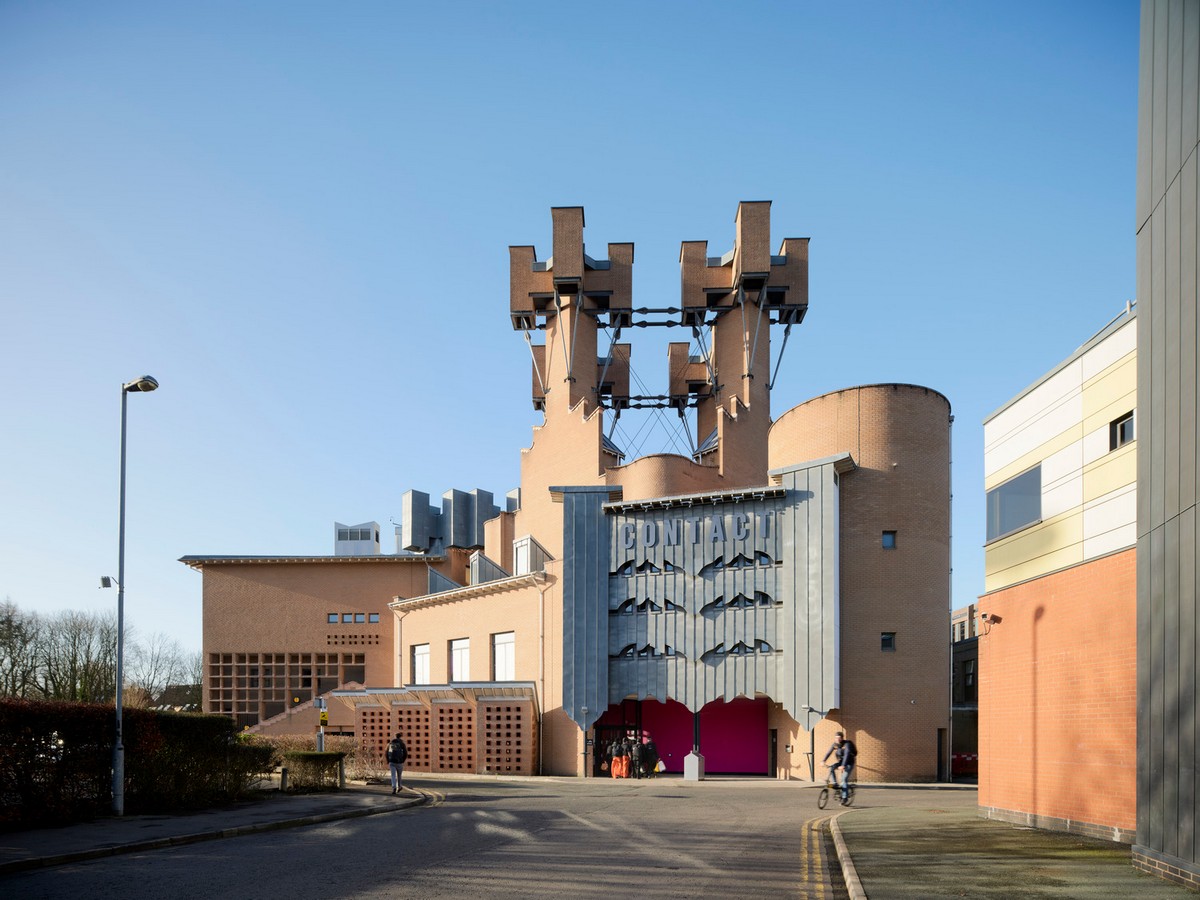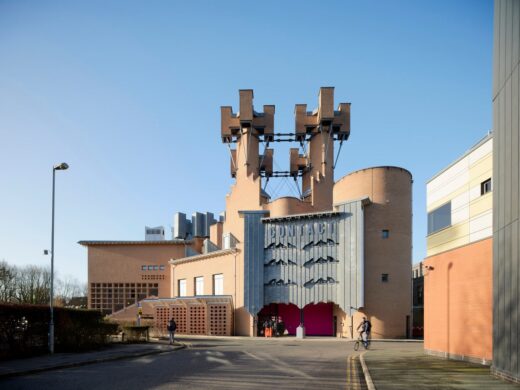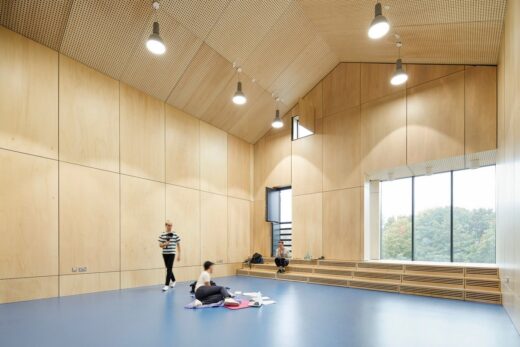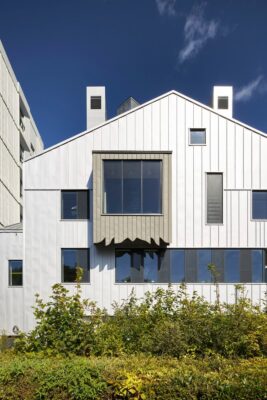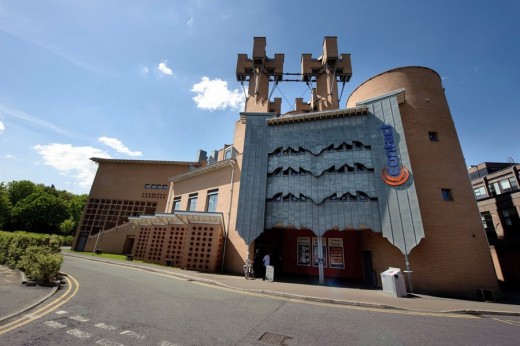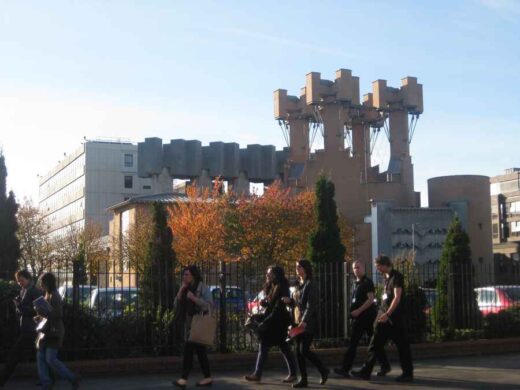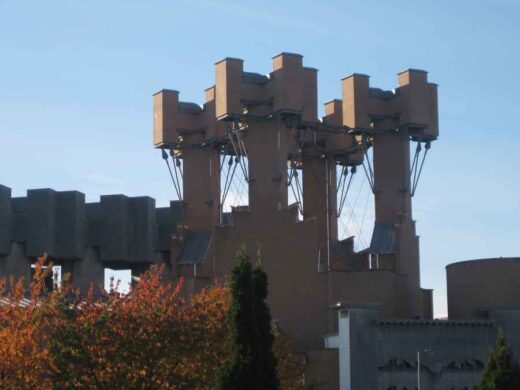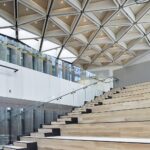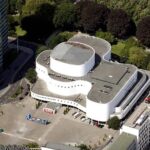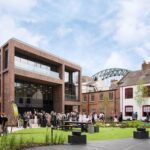Contact Manchester Arts Venue Renewal, English Architecture Photos, Design, Architect
Contact Manchester Theatre and Arts Venue News
2 March 2022
Location: Oxford Road, Manchester, Lancashire M15 6JA, Northwest England, UK
Design: Sheppard Robson, Architects
Photos by Adrian Lambert
Sheppard Robson complete revamp Contact Manchester arts venue
Making Contact: the completed refurbishment of the pioneering youth-led Theatre uses co-creation to build on its sustainable heritage
Contact Manchester Arts Venue Building Design
Contact, the UK’s leading theatre and arts venue with young people at its heart, has reopened its doors to the public following a major refurbishment and extension. This has been driven by a project team that includes architects Sheppard Robson, Max Fordham as M&E and acoustic engineers, Civic as structural engineers and Theatre Projects as theatre consultants.
This next stage in the building’s evolution saw Contact remodel its existing spaces as well as creating 300m² of additional space, improving upon the building’s original pioneering sustainable design as the first naturally ventilated theatre in the UK.
The new and improved performance and event spaces include a purpose-built recording studio for young people’s music projects and a unique health and science development space created in partnership with the Wellcome Trust. The building has improved public circulation and is now accessible to all. There are also new offices for artists and cultural organisations to hire and work alongside Contact staff; and a new and improved public café-bar with free work and social spaces.
Co-creation
The changes to the theatre needed to reflect the identity of the organisation as well as make physical upgrades. For this, Contact created its consultant group – Con:Struct, a team of young people associated with the Theatre that played a pivotal role in ensuring that the developing design reflected not just the needs but also the ‘attitude’ of its members, staff and audience.
This co-creation approach was vital to the success of this project. The Con:Struct team contributed to many aspects of the project, from the appointment of the project team and contractor to the sustainability strategy and details such as the new interior colours. With its youth-governance, the running of the project mirrored the running of Contact itself, which has young people on its board helping set the strategic direction of the organisation.
Sustainability
Alan Short’s original design, developed with Max Fordham in the 90’s, was innovative due to its natural ventilation – it was the first naturally ventilated theatre of the modern age. The building already had a remarkably low-carbon performance prior to refurbishment, but one of the commitments made to secure Arts Council England funding was to further improve on the building’s already highly sustainable performance. The upgrades are predicted to reduce overall carbon emissions by 13%.
An early assessment by Max Fordham indicated that natural ventilation was still the most energy efficient strategy. The new extension includes two new chimneys, to compliment those originally designed by Short, for natural ventilation of the new performance space and offices. The building users are highly engaged with their building, so there was a desire not to overly automate the offices. Natural ventilation in the open plan offices is manually controlled but with BMS advice on when to open windows and chimneys based on air quality and temperature.
The new natural ventilation chimneys and ventilation flows were used by Sheppard Robson, alongside complex people flows, as a principal driver for the architectural composition of the new spaces. Like with the Alan Short project, the natural ventilation is conceptually integral with the whole design.
Improvements in control allow the theatre to monitor air quality and control the air flow rates of the existing natural ventilation system. This innovative variable flow natural ventilation system will minimise the heat loss caused by over-ventilation in the winter, and provide night cooling of the thermal mass in summer to limit overheating and negate the need for any comfort cooling in the building.
The new offices replace inefficient and poorly daylit cellular offices with fully naturally daylit workspaces that minimise overheating using overhangs, external shading and optimised fenestration design.
Other design aspects which contribute to carbon reduction include replacement of all lighting with LED technology, including the main performance space, and the office area redesign. A kill switch at the front door allows all the building’s lights to be switched off by the last person out.
New central heating plant replaces the 20-year-old boilers for more efficient heat generation. Better zone control has been provided to limit overheating and underheating of the previous system.
Now that the theatre company are back in the building, Max Fordham are providing two years of aftercare ‘Soft Landings’ to monitor energy consumption in use and provide advice on optimisation of the systems in the building. This Soft Landings process began at concept stage to ensure the building designed was in full collaboration with all users.
James Jones, partner at Sheppard Robson, said:
“It’s so satisfying to see Contact’s many different spaces back in use. The building’s renewal required a huge amount of care – not just in the refurbishment and extension of the fabric of the building but also ensuring the project feels like it belongs to Contact and speaks of its principles and spirit.”
Iain Shaw, partner at Max Fordham:
“What an opportunity to get under the skin of this iconic building, that was at the leading edge of thinking when we refurbished it in the 90’s. With this latest refurbishment and extension project it was great to bring the theatre back to the forefront of exemplar low carbon and passive design. It was only possible because of the engagement and enthusiasm of the unique Contact Theatre organisation, whose purpose is to support future generations and the world they will inherit. I hope we’ve done them proud.”.
Matt Fenton, Artistic Director and Chief Executive at Contact Theatre, said:
“It was incredibly rewarding to work with architects and a design team willing to take on Contact’s ethos of involving young people in all major decisions. They created the time and space for this throughout the project, from inception to completion, and our wonderful new creative spaces and facilities are a testament to the deep engagement of our young building-users in the project.”
Acoustics
An early acoustic assessment indicated that the existing performance spaces had low ambient levels and good clarity, making them ideal spaces for theatre performance. Therefore, the focus was on improving sound insulation while ensuring that the existing acoustics were not compromised.
The theatres make use of pioneering acoustically attenuated natural ventilation chimney stacks. The new spaces also follow an attenuated natural ventilation strategy, which has been developed to control noise ingress from the nearby road.
Architectural form
The design proposals sit respectfully alongside the distinctive 1990s building designed by Alan Short and Associates, whilst providing an eye-catching addition to the south-facing elevation, making the building and the activities that take place inside it much more visible from Oxford Road.
The new three-storey extension adopts a pitched roof form with individual elements of the new accommodation, arranged around the new vent chimneys, carefully articulated and finished in a playfully detailed raised seam metal cladding. Using both aluminium and zinc, the facade materials give a varied appearance as the light changes through the day and respond thoughtfully to the materiality of the 1990s building.
Funding
The project has been funded thanks to a £3.85million investment from Arts Council England plus generous grants from other supporters, trusts and foundations.
About Contact
Contact is recognised nationally and internationally as a game-changer in the field of youth leadership and creativity. Contact works with the young people of Greater Manchester and with local, national and international artists to create new models of arts engagement – fostering new talent, building skills and ambition – and creating important new productions that tour nationally. Contact is unique in its ethos of placing young people’s decision-making at the heart of everything. Young people work alongside staff in deciding the artistic programme, making staff appointments and act as full Board members. This model is seen as a national exemplar of best practice in relation to young people and diversity, influencing organisations nationwide.
www.contactmcr.com
About Max Fordham
Max Fordham LLP is an environmental building services engineering consultancy, pioneering in sustainable design and low-carbon engineering. For over 50 years, they have engineered air, light, sound and energy to bring buildings to life. From their offices in London, Cambridge, Edinburgh, Manchester and Bristol, they have worked with the world’s leading architects on some of the world’s greatest buildings. Max Fordham’s portfolio includes award-winning exemplars of sustainable design and a diverse mix of beautifully engineered buildings.
Max Fordham is at the forefront of Net Zero Carbon (NZC), sustainable building design, Passivhaus and Soft Landings, as well as having in-house specialists in Embodied Carbon, Circular Economy, and the NZC verification process. As a practice they are signatories of the World GBC Net Zero Carbon Buildings Commitment, were the first business to have their offices verified against the UKGBC’s Net Zero Carbon Framework, and have published the Net Zero Carbon Guide (www.netzerocarbonguide.co.uk).
• Website: maxfordham.com
• Twitter Handle: @maxfordhamllp
• Instagram Handle: @maxfordhamllp
Contact Manchester theatre and arts venue images / information received 020322
Previously on e-architect:
5 Feb 2015
Contact Manchester Arts Venue Design
Sheppard Robson appointed to revamp Contact Manchester arts venue
Contact Theatre, south end of Oxford Road campus
Photos: Adrian Lambert
Location: Oxford Road, Manchester, Lancashire M15 6JA, UK
Website : Contact Manchester Arts Venue
Architects: Sheppard Robson
Manchester, Northwest England, UK
Manchester Buildings
Contemporary Manchester Architecture
Manchester Architecture Walking Tours
Contact Manchester architects : Sheppard Robson
Design: Mecanoo
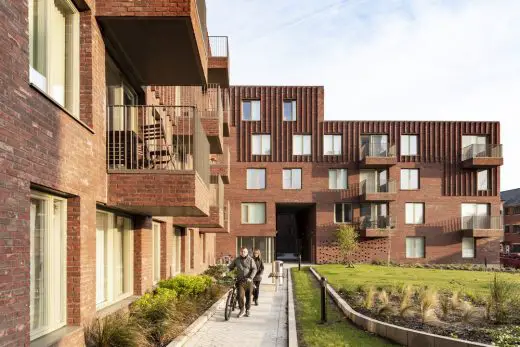
photo : Greg Holmes
Hulme Living Leaf Street Housing
Architects: Stephenson Studio
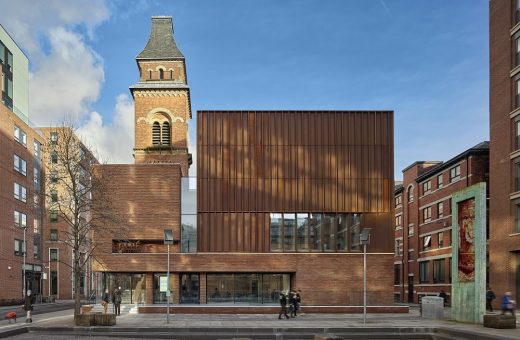
photo : Daniel Hopkinson Architectural Photography
Extension to Hallé St. Peter’s, Ancoats
Great Marlborough St Tower
Design: Hodder + Partners Architects
Great Marlborough Street Tower
Manchester Arts & Cultural Centre
Design: Mecanoo
Manchester Arts & Cultural Centre
Airport City Manchester
Design: 5plus Architects
Airport City Manchester
Manchester Central Library Redevelopment
Design: Ryder Architecture
Manchester Central Library
Comments / photos for the Contact Manchester theatre and arts venue page welcome

